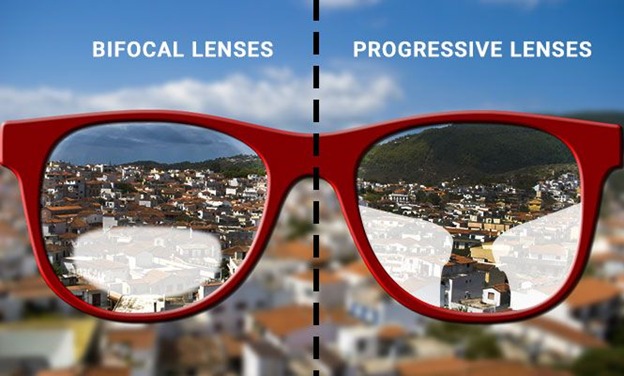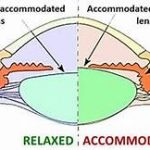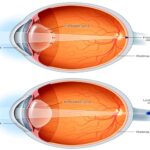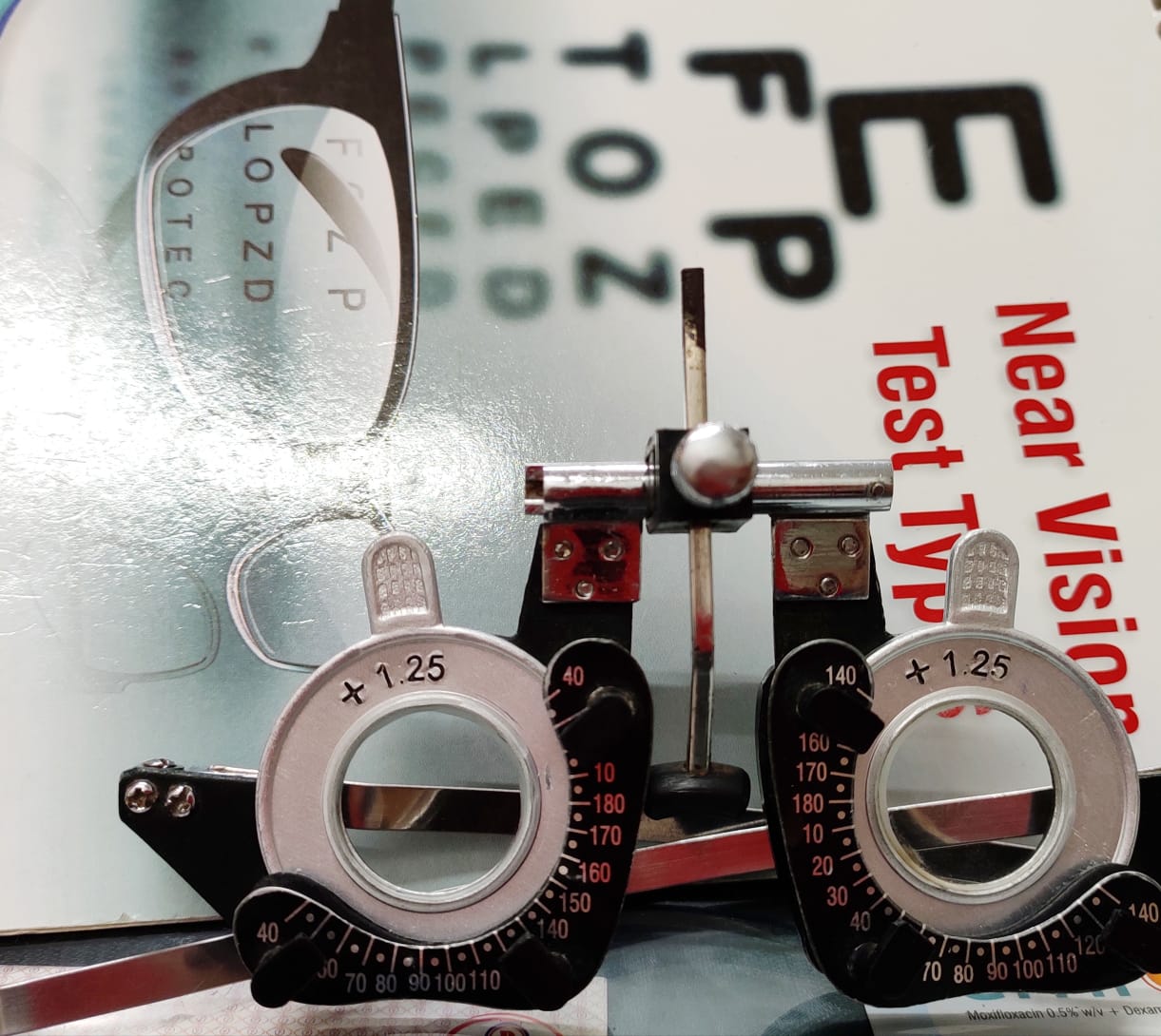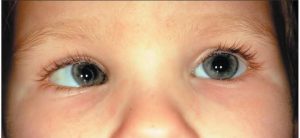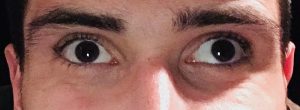What is a Bifocal Lens ?
A Bifocal lens is an ophthalmic lens specially designed to compensate for visual deficiencies, such as ‘presbyopia’, combined with other various ametropias.
Presbyopia (Greek word) means ‘age of sight’. It is not same as farsightedness. It is a gradual loss of accommodation and happens to almost everyone at their mid-40s. In reading glasses the whole spectacle lenses contains the correction power for close objects, but the distance objects look blurred.
Bifocals are two lenses in one. Bifocal lenses have different powers for upper (for distant vision) and lower (for near vision) segments.
History of Bifocal Lens :-
The American Statesman and inventor Benjamin Franklin first invented the bifocal lenses, most likely in 1760s or early 1770s.
Franklin required glasses for most of his life and began to need reading glasses to see close objects as he got older. So, instead of changing lenses, he came up with an idea of attach two lenses, one for far vision and one for near vision into one glass. This is how bifocal lens is invented which he called initially ‘double spectacle’.
The word ‘bifocals’ was created at the same time when John Isaac Hawkins invented ‘trifocals’ glasses (meant to focus on three different distances) in 1824.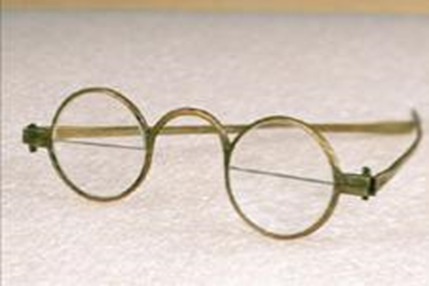
Segment Architecture of Bifocals:-
Segment is part in which the spectacle are divided and architecture is a design and construction of the spectacle. These includes the followings,-
- Centration Point (CP). The near addition is usually placed on inferonasal part of the spectacles because the eyes are lowered and converged while reading. So near addition must have different CP than the distance correction.
- Segment Shape is the form of the segment.
- Segment Top is the highest top of the segments.
- Segment Height is the vertical measurement in millimeters from the bottom of the lens in frames to the top line of lined bifocal.
- Segment Width is the measurement of the segment side to side.
- Segment Inset is the horizontal distance between the Major Reference point and the Segment centre.
- Segment Diameter is the diameter of which the boundary of finishing segment forms a part.
- Segment Drop is the vertical distance from the segment top to the distance optical centre.
- Segment Depth is longest vertical measurement of the segment.
- Major Reference Point is also the Optical Centre of distance lens when no prism has been prescribed.
- Segment Size
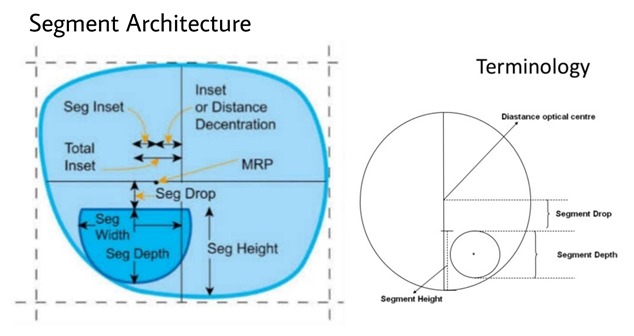
Different Types of Bifocal Lenses :-
The most common types of bifocal lenses are the followings,-
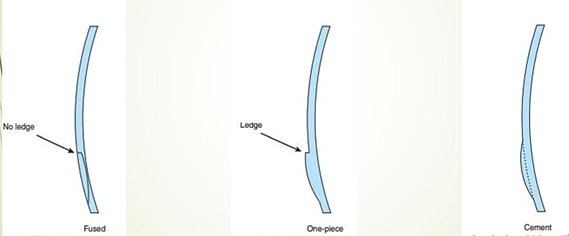
- Cemented Bifocals:
- These bifocals were first invented on 1888 by Morck.
- Manufacture Process: Cemented bifocals were made by grinding distance and near segment separately, and then the near segment was sticked on the anterior surface of the distance correcting segment by glues like epoxy resins or Canada balsam.
- In these bifocals, Centration point was easy to administer and the additions (near segment) could be removed or replaced while the presbyopia increased or decreased.
- Disadvantages: The segment could get displaced or may fell off and another limitation was the discoloration and brittleness of glues.
- Solid Bifocals:
- Also known as One-piece bifocals, are the most frequently used bifocals and were introduced in 1906.
- Manufacturer Process: These are manufactured with single piece of lens material- glass or plastic (this solved the chromatic aberration)- then add up the power coming from extra shape of segment.
- Changes in curvature can varies the power of these lenses.
- Disadvantage: As the near field of view is increased in Solid bifocals, it have restricted field of vision in distance.
- Fused Bifocals:
- The first fused bifocal was invented and popularized by Brosch in 1908. They work on the principal that difference in the refractive index at any interface produces refraction of light rays at that interface.
- Manufacture Process: Two different types of materials were used to made up these lenses and to achieve the increased refraction needed for near, the addition is made up of flint glass of higher refractive index than the crown glass of distance correction and fused those segments.
- Disadvantage: As flint glass has got more dispersive power, chromatic aberration are produced while reading and image jump is one of the inherent effect.
Now, Segment wise Bifocals are also divided in following types,-
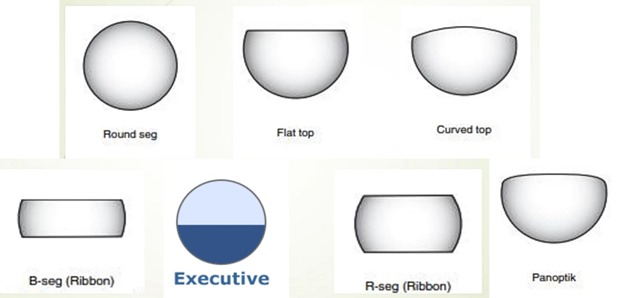
- Flat-top Bifocals:
- It also called Half-moon or D-seg or straight-top lenses, these lenses have two sections in which the near segment is shaped like the letter D turned sideways within.
- Available segments width are- 22, 25, 28, 35, 40, 45.
- Optical Centre (OC) lies 5mm below the segment top.
- Image jump is lesser and the prismatic effect induced.
- Round segment Bifocals:
- It also known as Kryptop bifocals, has a near segment with a single circular arc as a dividing line which is least visible compared to the other bifocals. When these lens are fitted in a spectacle, the near segment is shaped like semi-circle.
- Available seg width- 22, 24, 25, 38, 40.
- OC lies at the centre of the segment.
- Curved-top Bifocals:
- It also known as C-seg bifocals, the upper dividing line of the near segment is curved like C.
- Available seg width are- 22, 25, 28, 40.
- OC lies 4.5 mm below the seg top.
- Cosmetically appealing, image jump lesser.
- Panoptic Bifocals:
- It has a modified smooth curved corners in the near segment (not like the flat-top bifocals which have shape edges in near segment).
- Available seg width- 24 and 28.
- OC lies 4.5 mm below the seg top.
- Ribbon segment:
- It has a narrow rectangular area. These can also divided in,- R- seg(wider segment) and B-seg (less wider segment) bifocals.
- B-seg: 22 or 25 mm wide and 9 mm deep. OC lies 5 mm below the seg top.
- R-seg: 22 or 25 mm wide and 12 to 14 mm deep. OC lies 7 mm below the seg top.
- In this lens there are some amount of distance segment is present in the lower part of the near segment.
- Executive Bifocals:
- It also called Franklin bifocals or E-style bifocals, are the most modern type of solid bifocals. Owing to location of centre of curvatures of distance and near corrections on the optical axis from where rays pass undeviated, image jump is totally negated.
- Seg width: full lens width
- OC lies on the line of bifurcation.
Clinical Significance of Bifocals:-
- Presbyopia: In case of Presbyopia, the ciliary muscles of human eye weakens and the flexibility of the crystalline lens is diminished due to old age. As a result eye loses its accommodative power and the person is unable to see the near objects clearly. Bifocals glasses have two segments, top half of each lens is for seeing far-sighted vision and the lower half is for near-sighted visions such as reading, which makes it easier for presbyopic patient to see clearly at two different focal distance.
- Accommodative Dysfunction: Accommodative Dysfunction is a condition where the eyes are unable to change focus for far to near, resulting in blurred vision up close or far away. Children and adults who develop this problem can also experience severe fatigue while trying to maintain focus during reading, sketching, learning in classroom or any kind of similar near activities. These patients may benefit from bifocal lenses while shifting focus.
- Accommodative Estropia: Accommodative Estropia is one of the most common forms of strabismus or eye misalignment in children. It refers to eye crossing that occurs due to over-action of convergence associated with accommodative reflex. It is also associated with refractive error (high hypermetropia), abnormal AC/A ratio or both. This condition can fully corrected by adding near vision in spectacles. So, a bifocal often alleviates the problem totally.
Disadvantages of Bifocal:-
- Bifocal Lens has only two segments- distance and near vision zones. Intermediate vision zone is missing in bifocals, which can be problematic for a patient who have more intermediate works like prolong usage of computer or any digital devices, drawing etc.
- Sometimes image jump occurs when the visual axis passes form far vision zone to reading zone.
- The prismatic effect on the near vision point that requires an apparent displacement of the fixed object as well as a degradation of its image quality.
- Bifocals lenses take time to adjust.
New Generation Bifocals: Digital Bifocal Lens:-
There is a new advanced technology of Digital lenses, available in both single vision as well as bifocal (no-line) and progressive lenses.
“Digital lenses are the new standard for your eyeglasses,” explains Matthew Alpert, O.D., board member and chairman of optometric innovation at VSP Global.
In this technology, personalized prescription lenses are available at up to 1/100 of dioptre accuracy for the first time.
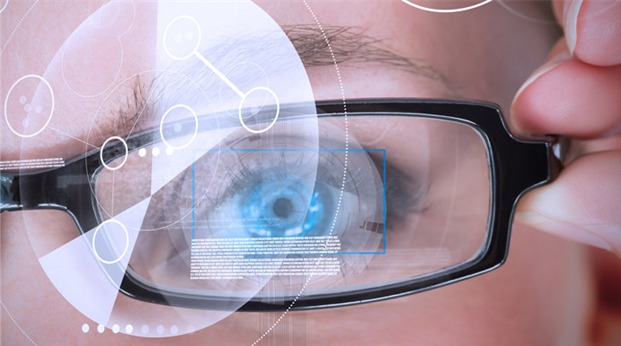
Most of the lenses are made using traditional vitriolic grinding process, while the digital lenses are manufactured by precise laser surfacing technology. As a result of this new surfacing technology, the lenses that are nearly six times more clear than traditional ones, with enhanced night-time and peripheral vision.
Digital Bifocal Lenses has no line, new generation, personalized lenses which are developed to be effective in both optical zones and without image jumps. It offers a natural transition along the natural eye-path from distance to near.
In addition to prescription digital lenses, there are also special, non-prescription digital lenses designed to shield your eyes from the potentially adverse effects of blue light, a high-energy wavelength of light emitted from fluorescent lights as well as from the screens of computers, TVs, tablets and smart phones.
Advantages:
- Improved aesthetics: By eliminating the visible dividing line.
- Optical benefits: As there is no image jump between zones
- Fully personalized: So there are unique lenses for each patient.
- Fully compensated: Enhanced vision zones.
- Availability: Can be made in wide range of lens materials, with high prescription and large amount of astigmatism.
- Blue-Light Blocking: Frequent technology users, children younger than age 18, post-cataract patients, and individuals at risk of age-related macular degeneration, in particular, should consider blue light-blocking digital lenses.
- Cosmetically appealing: For all the presbyops, as well as other visual deficiency patients.
- Ideal solution: For previous bifocal users, non-adapted progressive wears.
Difference Between Bifocal & Progressive lenses :-
| Basis of Comparison | BIFOCAL LENS | PROGRESSIVE LENS |
| Horizontal line | Bifocal lenses commonly have a half moon shaped. | Progressive lenses have no demarcation line. |
| Duration of Adjustment | A regular user of bifocal may find it more comfortable than progressive glasses when they will switch to a new pair of progressives. | A regular Use of progressive glasses on a daily basis, they will find the comfort provided by it is more than a pair of bifocal glasses. Since there is a sudden shift of focus in case of bifocal glasses, the eyes take time to adjust. |
| Design | The bifocal glasses have two separate focal points in a single lens. The upper part is for distance vision and the lower part helps for near vision. The upper part view distant objects clearly, and the lower portion allows you to do near work, use a phone, etc. | The progressive glasses have three different focal points, they are for distance, intermediate and near vision. The middle part of the lens provides intermediate focus, which is helpful in focusing on the intermediate objects like laptop/computer, cooking, etc. |
| Image Jump | Image jump occur in Bifocal lenses. | Progressive lenses have no image jump. |
| Cosmetic Appearance | Cosmetically less appealing. | Cosmetically more appealing than the bifocal lenses. |
| Cost | Pocket friendly. | More expensive. |
Conclusion:-
There are many different variations of lenses available today, many of them fulfilling the same purpose or even multiple purposes. Generally, when wearing bifocal lenses, one look up and through the distance portion of the lens when focusing on points farther away, and one look down and through the bifocal segment of the lens when focusing on reading material or objects within 18 inches of your eyes. There is also an option of using progressive multifocal lenses which also covers intermediate zone. But whatever one chooses, it is advisable to do under the supervision of an Optometrist or Ophthalmologist. As they do care for your eyes, they will guide you better.
Credits:-
- AK Khurana, Professor, Regional Institute of Ophthalmology, India : Theory and Practice of Optics & Refraction: Spectacles- Single versus Multiple Power Lenses: 226-228
- Gary Heiting, OD: Bifocals And Trifocals: Solutions For “Short Arms”: All about Vision, February 2021: https://bit.ly/3xSnnzV.
- What are Digital lenses?- July 30, 2015: https://bit.ly/3vXVNja.
- Bifocal: History of Bifocals- https://bit.ly/3vXzEBQ.
- Lens Technology: Relf Optical: https://www.relfeyecare.com/lens-technology/
- Tory Bedinghaus, OD; Medically reviewed by Ami A. Shah, MD: Do you need Bifocal lenes?- October 01, 2020: https://bit.ly/3vYsIo3.
Image 1, 2, 3, 4, 5: https://bit.ly/2U14zzN; https://bit.ly/3h4z4wA; https://bit.ly/3xS8Ns1.

